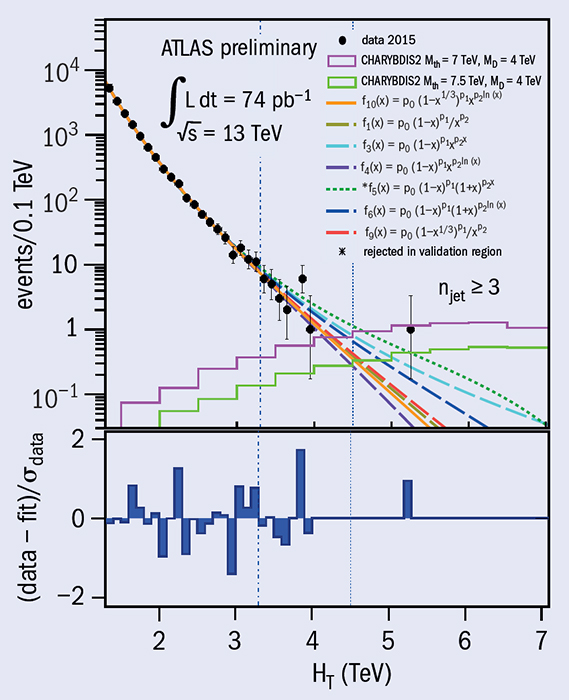
After demonstrating a good understanding of the detector and observing most of the Standard Model particles using the first data of LHC Run 2 collected in July (CERN Courier September 2015 p8), the ATLAS collaboration is now stepping into the unknown, open to the possibility that dimensions beyond the familiar four could make themselves known through the appearance of microscopic black holes.

Relative to the other fundamental forces, gravity is weak. In particular, why is the natural energy scale of quantum gravity, the Planck mass MPl, roughly 17 orders of magnitude larger than the scales of electroweak interactions? One exciting solution to this so-called hierachy problem exists in “brane” models, where the particles of the Standard Model are mainly confined to a three-plus-one-dimensional brane and gravity acts in the full space of the “bulk”. As gravity escapes into the hypothesized extra dimensions, it therefore “appears” weak in the known four-dimensional world.
With enough large, additional dimensions, the effective Planck mass, MD, is reduced to a scale where quantum gravitational effects become important within the energy range of the LHC. Theory suggests that microscopic black holes will form more readily in this higher-dimensional universe. With the increase of the centre-of-mass energy to 13 TeV at the start of Run 2, the early collisions could already produce signs of these systems.

If produced by the LHC, a black hole with a mass near MD – a quantum black hole – will decay faster than it can thermalize, predominately producing a pair of particles with high transverse momentum (pT). Such decays would appear as a localized excess in the dijet mass distribution (figure 1). This signature is also consistent with theories that predict parton scattering via the exchange of a black hole – so-called gravitational scattering.
A black hole with a mass well above MD will behave as a classical thermal state and decay through Hawking emission to a relatively large number of high-pT particles. The frequency at which Standard Model particles are expected to be emitted is proportional to the number of charge, spin, flavour and colour states available. ATLAS can therefore perform a robust search for a broad excess in the scalar sum of jet pT (HT) in high-multiplicity events (figure 2), or in similar final states that include a lepton. The requirement of a lepton (electron or muon) helps to reduce the large multijet background.
Even though the reach of these analyses extends beyond the previous limits, they have so far revealed no evidence for black holes or any of the other signatures to which they are potentially sensitive. Run 2 is just underway and with more luminosity to come, this is only the beginning.








